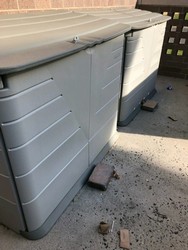Any time you receive an email from a faculty member on campus, you will see on their signature right below the Monmouth University logo, a green leaf. Next to the leaf, it reads, “We are a green campus. Think before you print.”
It’s blasphemous that this “green campus” does not practice what it preaches.
In my junior year at Monmouth, one thing has never changed: our lack of recycling. Sure, you see the recycling bins in every building. There are even some recycling bins placed side by side with no trash bin alternative next to it, like right outside of The Outlook’s office.
But in fact, when you place your plastic cup or food containers in the recycling bin, it does not matter. Most custodians combine the recycling into the same bags that hold the trash.
On an even more troubling note, there are plenty of trash bins campus-wide that are not labeled for recycling or trash.
This has been a particular problem in the residence halls, where for two months into the academic year, the halls had no labels on their bins. So for all this time, residents who have been environmentally conscious in separating their recycling from trash, have made no difference.
None of the dumpsters outside of Cedar, Maplewood, Spruce, and Willow Halls feature recycling options. In addition, throughout the residential side of campus, there are unlabeled bins, like directly in front of Redwood Hall. These unlabeled bins are riddled throughout campus, including on the side entrance of Pozycki Hall facing Bey Hall.
But let’s just imagine how much trash is amassed in a residence hall every day. According to the EPA, an American person throws out 5.91 pounds of trash per day, with 1.51 pounds being recycling.
Considering there are over 100 students living in each building, that is well over 591 pounds of trash per day and 151 pounds of that recycling. Over the span of two months, that is over 9,060 pounds of recycling thrown into the trash. Mind you, this is just for one residence hall and not accounting for the thousands of people who come to this campus every day.
When the custodians do combine the two, the recyclables are assumably and hopefully separated by a waste management company. But the more separating they have to do, the more they will charge. Hence, on account of facilities’ laziness of not separating our recycling from trash, like they are supposed to, it would in turn come out of the student paid tuition.

However, this is a much bigger issue than paying for the expenses of separating recycling from trash. We recycle to help the environment. The more we recycle, the less dependent we become on creating new raw materials, which lowers pollution.
There are so many benefits to recycling like the saving of energy, reducing greenhouse emissions, keeping the environment clean for generations to come, and more. Yet, all of these benefits are just combined with the trash every day.
This is why for my past three years living at Monmouth University, I have never recycled here. Instead, I take my recycling home because I know that my plastics and paper will actually be recycled. Most of the time I take home a few bags; some are mine and others are from my peers I live with on campus. They know the University does not recycle, so whenever I go home they ask if I can take their recycling with me.
Even if leadership decides to place proper labels on bins, you can’t help but still question if it will mean anything. Yes, the bins will have the labels, but will leadership make sure the custodians are actually abiding by them? There is blame to go around from the top to the bottom.
Climate change is the top issue our world faces today. The globe’s temperature is rising at an astounding rate and at some point in the near future, this place we call home may be uninhabitable for the next generation.
Taking this into account, we need to do everything we can to reduce our carbon footprint as much as possible. This includes recycling every bit of plastic we can or not using single-use plastics at all.
With my experience at this University, it is clear that they have no regard for this. University employees may have a little leaf next to their signature, but it is a lie.
Until President Leahy, the Sustainability Advisory Council, or facilities takes note of this epidemic on campus, our carbon footprint will only grow larger.
PHOTO’S COURTESY of Ryan Thompson



